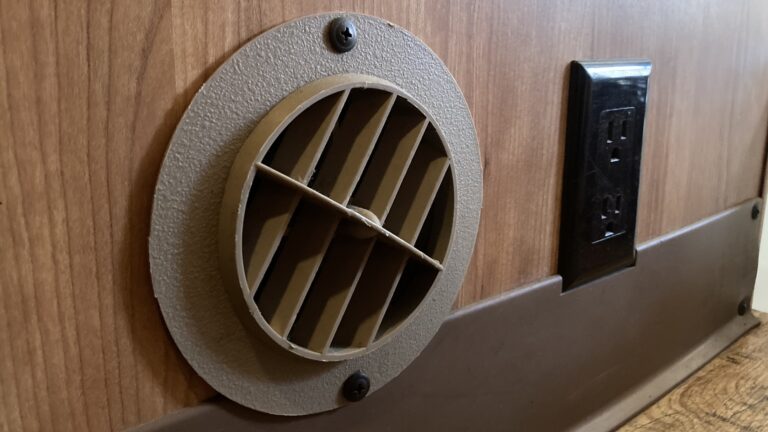
When I was a kid, I went to my (very indoorsy) parents with a not-so-strange proposition; I wanted to go camping.
My parents smiled and agreed, but since we were in Florida, my folks had decided that camping without AC simply wasn’t an option and honestly, the furnace was pretty nice to have in winter as well.
If you’re anything like my parents, your RV HVAC system is pretty important to you. Learning more about your AC unit and furnace can help you understand and get ahead of pesky issues. It may also save you a heap on repair bills.
In this guide, we will teach you everything you need to know about your RV HVAC system.
This post contains affiliate links. RVshare may receive compensation if you make a purchase after clicking on a product link.
How Your RV HVAC System Works
Let’s start by discussing the various components of your RV’s HVAC system and how each one functions to keep you comfy while out camping.
RV Furnace and Heat Pump
The vast majority of RVs are equipped with heaters. Almost all include a propane furnace and some modern RVs also come equipped with AC heat pumps. The main difference between the two? The furnace is run off propane gas, while a heat pump uses electricity to warm your RV — and is, oftentimes, a part included in the rooftop AC unit.
When you’re in a campsite that’s connected to shore power, using a heat pump to warm the rig can save you money on propane. That said, your heat pump isn’t built to handle extremely cold temperatures. Below about 45 degrees, it’ll struggle to maintain a comfortable living temperature inside your RV. In fact, it might quit working altogether.
Your RV’s propane furnace is the camper heater you’ll want to turn to if you’re traveling in an extreme winter climate. This unit works by warming air using propane fuel. A fan then pushes the warm air through your RV vents, keeping you nice and toasty.
RV Air Conditioner
Most modern air conditioners use special cooling chemicals called refrigerants to help lower the temperature of hot ambient air. Basically, the AC unit picks up the hot air in the vehicle via an intake vent, and then runs the air over evaporator coils, which have these refrigerants inside them. Thus, the heat in the air transfers to the refrigerants in the evaporator coils.
However, when they take on that heat, the refrigerants convert from a liquid state to a gaseous one. And when they’re in a gaseous state, those refrigerants can’t help you cool any more hot air. In order to keep you sweat-free, your RV AC unit then has to transform those refrigerants back into liquids, which is done with a compressor.
The compressor puts so much pressure on the gaseous refrigerants that they turn back into liquids, dispelling the heat they took from the air in the process. That heat is then directed outside of your RV with the help of condenser coils, as well as an RV vent and fan system.
Best RV Air Conditioner Heater Combos
Looking to install a new RV AC and heater combo? There are several good options on the market. Below are our top picks. We chose these based on a variety of factors including durability, ease of installation, value, and noise level.
- RecPro RV Air Conditioner 15K – Best Overall
- TOSOT GO COOL RV Air Conditioner 15000 BTU – Best for Extreme Temperatures
- BALIGO RV Rooftop 12V Air Conditioner with Heat – Best for Small Space
RV HVAC Installation and Troubleshooting
Ready to install a new RV AC unit, troubleshoot your HVAC system, or simply do some RV AC unit maintenance? Here’s what you should know.
Step-by-Step RV HVAC Installation
If you decide it’s time to buy a new RV AC unit, you may be hoping to save some money by installing it yourself. Depending on your skill and comfort level with electrical projects, this is possible — but we always recommend you seek professional help if you have any doubts.
The specific steps for preparing, mounting, and installing your RV AC unit will vary depending on which brand and model you choose, as well as your RV’s existing air conditioner setup. Be sure to check that your new AC unit will work with your current configuration before you spend hundreds of dollars on it!
Although it’s important to consult the RV AC manual for full, step-by-step installation details, we can provide a few general pointers here.
- You’ll need to remove the old AC unit — or, if your RV came without one, you’ll need to create a roof vent to hold your AC unit.
- If you’re removing an existing unit, be sure to get all the screws and carefully scrape away the caulking or sealant; you want to ensure you’ll get just as tight and waterproof a fit with your new unit!
- You’ll also need to ensure that the existing wiring matches your AC’s requirements, or install proper new wiring if you’re starting from scratch.
- Don’t use the AC unit’s exterior shroud (the outside casing) to lift it; even lightweight ACs are sometimes about a hundred pounds and should be lifted from the bottom.
- When you’re matching the unit up with your RV’s AC vent opening, make sure it’s facing the right direction — sloped part forward!
This tutorial is specifically for an ultra-low-profile Coleman RV air conditioner unit, but many of the steps and techniques can be applied to a variety of different types of RV ACs.
Troubleshooting your RV HVAC System
Some of the most common issues AC units run into are relatively simple to fix. Here are some basic troubleshooting tips that may help when your RV air conditioner or furnace isn’t working properly.
Thermostat Problems
In many cases, the trouble may not be with the furnace or AC unit, but rather with the thermostat. Always check the thermostat first when there’s an issue with your RV heating and cooling. If the thermostat is battery-operated, it might be time to change the battery; if it’s electrically wired, the issue may be local rather than within the heating or cooling unit.
Furnace Motor Won’t Run
If you don’t hear the blower motor kick in when it should, you have some sort of electrical issue. First, check the furnace fuse. If it’s blown out, replace it to see if that gets your furnace going again.
If the fuse isn’t the issue, you likely have an issue with the thermostat, module board, or the motor itself. In this case, we recommend calling a pro to take a look.
Furnace Motor Runs, but Nothing Else Happens
If you’re hearing the motor start, but nothing else is happening after you probably have a failed sail switch on your hands. Sometimes the switch is just stuck. If this is the case, working with the switch a little will get rid of the issue. If that does do it, you will need to replace the switch altogether.
Another issue that causes this symptom? A bad high-temperature relay. Test the voltage on the lead board from the high-temperature relay to see if this is your problem.
Furnace Won’t Light
Sometimes your blower motor is working fine, but the furnace won’t light. Some issues that cause this include bad igniter placement, a bad gas valve, and most commonly: critters.
The thing is, bugs really like to make themselves at home in RV furnaces, particularly the gas tubes and combustion chamber. We recommend cleaning both to see if this might be your problem.
AC is Blowing Warm Air
Is your AC blowing warm air? Start by testing the compressor with a multimeter. If it’s testing bad, you’ll want to replace the entire AC unit rather than just the part. If it turns out the compressor is just fine, it could be that a capacitor is causing the problem. Discharge the capacitors first, then test them with a multimeter. A DIY capacitor replacement is 100% possible.
AC Has Weak Airflow
Noticing that the airflow from your RV air conditioner is very weak or even non existent?
- First, check the evaporator coils for ice. If you see ice, turn the AC to ‘fan’ and run it on high until the ice has melted.
- A clogged air filter or super dirty coils can also lead to weak air flow. Clean both.
- You could also have a leak or hole in your ductwork. Search for places where cold air might escape the system and seal each potential leak point using metal tape and caulking strips.
- Lastly, a lack of airflow can be caused by a broken fan motor. Clean and oil your fan motor. If it you find the motor needs to be replaced, you can call in a professional, but it also possible to attempt to do it yourself.
AC is Cycling On and Off
An AC unit that cycles on and off too often could be caused by a few different things.
- Often, this particular issue is caused by a bad control board or faulty thermostat in both cases, you will want to call in a professional.
- Another possibility? A weak capacitor. To find out if this is your problem, discharge both capacitors and test them with a multimeter. You can replace a bad capacitor on your own.
- A frozen AC unit can also cause an RV AC to cycle on and off. Check the coils for ice. If you see ice on the coils, turn the unit to ‘fan’ mode. This will allow all ice to melt and should solve the problem.
RV AC Maintenance
Maintaining your RV air conditioner will help ensure you don’t have to deal with issues while out camping. Here are the basic steps you should take when maintaining your unit.
- Filter Changes – Change at least once a month during the summer and at the beginning and end of the season.
- Checking the Coils – Check the coils on the outside of the RV. Clean off any build up and straighten bent coils.
- Watching for leaks – Watch for leaks around the AC. If you notice water coming in, tighten the bolts holding the unit in place.
RV HVAC FAQs
Still have questions about your RV HVAC system? We have answers below!
Can I run my RV HVAC system unit while boondocking?
Yes and no. Your RV furnace can be run absolutely anywhere as long as your RV battery has a charge. That said, RV air conditioners and heat pumps require a lot more electricity. This means you will need a generator or a huge battery bank and a hefty inverter to run these things while boondocking.
What are some other options for heating my RV?
If you find that heating your RV using the propane furnace costs way too much due to the cost of propane, there are other options. Obviously, you can use a heat pump if it isn’t too cold. However, for camping in truly cold weather, we recommend a couple of small space heaters.
What are some other options for cooling my RV?
Swamp coolers are one option, but these only work well in dry climates. Another option is to head north for summer and use your rooftop vent fans to keep cool.
What do I need to be safe while using my RV propane furnace?
You will want to make sure you have a working carbon monoxide and propane detectors before running any propane appliances in your RV. This includes the furnace. Check the detectors often and change them out/change batteries when needed.
By now you know everything you need to know about your RV HVAC system, so you can hit the road in complete comfort. Why not get out there and make good use of your RV’s heating and cooling systems?






